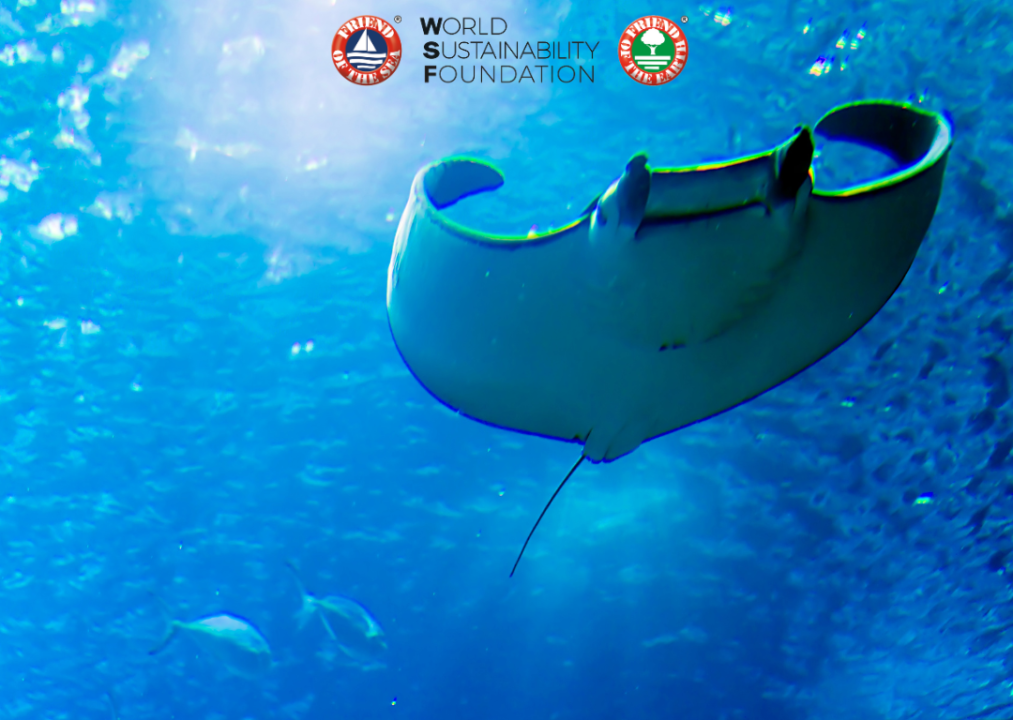The Manta, known to have the largest brain-to-body ratio of any fish, is among the largest animals in the ocean…discover more about the wonderful world of Mantas to commemorate World Manta Day.</span>
As the world marks Manta Day on September 17 annually; with the aim of raising awareness about the conservation of manta and devil rays, the World Sustainability Foundation takes you on a deep dive into the fascinating world of Mantas.
Everything you need to know about Manta
Manta Ray is a cartilaginous fish and a member of the family Myliobatidae, it reaches up to seven meters wide, and weighs over a ton.
Its body is constituted by a flat and ample rhomboidal disk, with pointed lateral apices and a head almost a third the width of the disk. The mouth of the Manta Ray is tremendously large and opens at the front end of its head, it also has very small teeth on the lower jaw. The tail is extremely thin and is separated from the body.
Manta Ray has five open gill slits on the ventral side of the body.
The colour of the Manta Ray varies from brown-olive to black on the dorsal surface, while the ventral side is white.
There are 2 species belonging to this genus:
- Mobula birostris, also known as ‘’Giant Manta Ray’’
- Mobula alfredi, which is the reef Manta Ray.
The main difference between the two species is precisely the size, Mobula birostris can reach up to seven meters wide, while Mobula alfredi does not exceed five meters wide.
NUTRITION
Manta ray feeds mostly on plankton and small fishes, capturing them on the surface. With fast movements of the cephalic fins, they convey towards the mouth a stream of water rich in planktonic organisms and small fishes: they are filtered by extensions of the branchial arcs, called ‘’gill rakers’’, which keep them at the passage of the water that will then be expelled from the gill slits.
Even if they have a set of teeth in the lower part of the mouth, they do not play a significant role in feeding.
REPRODUCTION
Manta ray is ovoviviparous (which means that reproduction takes place through internal fertilization) and the female gives birth to a live newborn. Pregnancy lasts over a year and the reproduction’s period is generally from the beginning of December to the end of April.
Sexual maturity is reached very late, due to the slow development of these specimens. In this specie, courtship involves many males, following a single female for a prolonged period until one male prevails and fertilization takes place.
WHERE DOES MANTA RAY LIVE?
Manta ray lives in the tropical and temperate-warm waters of all oceans, particularly near the coasts. In fact, it is in fact possible to see them swim mostly on the surface.
Mobula birostris is typical of the tropical and temperate oceans, while Mobula alfredi is more localised, for instance in the coral reefs of the Indo-Pacific Ocean and in some eastern parts of the Atlantic Ocean. However, both are absent in the Mediterranean Sea.
CONDITION AND MAIN THREATS
Currently Mobula birostris is classified as endangered, and Mobula alfredi is identified as vulnerable on the IUCN red list of threatened species. Both are endangered by climate change, induced by human activity. Their meat is not good for human consumption, but the dried gills are widely sought after in China, for traditional medicine, they are also accidentally fished without any purpose. Even conventional poaching is important in this case, with fishermen selling the Manta ray skin for shark skin, using it to manufacture handbags and shoes.
The decrease for these species has led to a number of restrictions, all under the CITES (Convention on International Trade in Endangered Species), which has incorporated Manta ray into the convention to regulate its fishing and international trade.
Another important factor to consider is that the low reproduction rate for these species adversely affects the number of specimens that remain.
5 FUN FACTS ABOUT MANTA RAY
- A common thought is that Manta Ray is dangerous for man, but in reality this animal is harmless, having neither poisonous teeth nor stings that can hurt
- It’s a very curious animal and has an excellent view: consider that several divers’s stories talk about Manta ray who, swimming elegantly, approached them up to a distance of 2 m just to observe them
- The name Manta ray means ‘’cloak’’, referring to the characteristic flattened shape of the body that resembles a blanket or shawl swaying in the waves. It’s also called ‘’Sea’s devil’’ or ‘’Devil fish’’, because of its long appendages on the sides of the head that look just like two horns, that is the cephalic lobes
- Many tend to confuse Manta rays and Rays, but they aren’t the same animals: at first glance they can look like, but Manta ray has eyes in lateral position and mouth in apical position, while Ray has mouth in ventral position and lives on the seabed
- A study demonstrated that Manta Ray can recognize their own reflection in the mirror: in fact, some researchers have observed that these animals react as if they recognize their own image. In technical terms, they passed the ‘’mirror test’’, often considered a measure of animal self-awareness and passed so far by a small number of species (mostly primates). It’s the first fish in which you can notice something like that!
The World Sustainability Foundation (WSF) is a non-profit organization dedicated to global social solidarity. WSF plays a pivotal role in Manta ray conservation, by raising awareness and generating funding for conservation initiatives. Now that you have discovered all there is to know about the Manta ray, kindly join the WSF in our efforts to protect and preserve Manta rays for posterity.
Happy World Manta Day!




